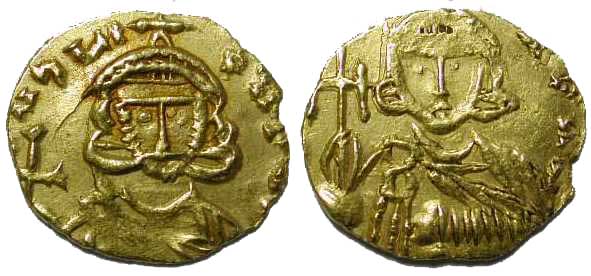| 717 AD - 741 AD |
Imperium Byzantinum
Λέων Γ' Ισαυρος ο Εικονομάχος Συρακούσαι
Βυζαντινή Αυτοκρατορία
| Semissis AV 15 |
SHH 140 |
 |
| Parameter Obverse Reverse Notes Reference |
1.93 g 13.9-16.1 mm 6:00
o'clock VF Facing bust of Leon with short beard facing, holding globus cruciger in right hand; blundered inscription clockwise around. Beardless bust of Constantine, wearing chlamys; holding cross potent on globe; blundered inscription around, partly off flan. Syracusae mint. BMC ---; Dumbarton Oaks 3/I 47; Ratto ---; Sear Byzantine 1526 |
Leo III "The Isaurian"
History & Numismatics
http://www.wegm.com/coins/byzantine/leo_iii.htm
"Yet in spite of
the clamors of superstition, a favorable prejudice for the character of
Leo the Isaurian may be reasonably drawn from the obscurity of his
birth, and the duration of his reign. Even in the corruption and
debility of the modern Greeks, the elevation of a plebeian from the
last to the first rank of society, supposes some qualifications above
the level of the multitude."
Gibbon, Decline & Fall
Whilst we in the west often claim Charles Martel to have "saved" Europe from Islam, in the annals of Muslim history Poitiers was nothing more than a border skirmish. If credit is due for heading off the Islamic explosion's entry into Europe, it belongs to the great Leo III. Not only did he spare Europe the Muslim advance, he also can be said to have saved the Roman Empire.
Unfortunately, the other great event of Leo's reign was the introduction of iconoclasm, the suppression of holy images. Centred on the belief that the worship of icons was clouding the worship of what the icons were representing, iconoclasm swept the images away as idolatrous. Possibly influenced by the Islamic proscription on graven images, iconoclasm was supposed to lead to a purer faith. The icons were too much a part of eastern faith though, and Leo and his successors efforts were to ultimately do great and lasting harm to the unity of the empire.
Gibbon, Decline & Fall
Whilst we in the west often claim Charles Martel to have "saved" Europe from Islam, in the annals of Muslim history Poitiers was nothing more than a border skirmish. If credit is due for heading off the Islamic explosion's entry into Europe, it belongs to the great Leo III. Not only did he spare Europe the Muslim advance, he also can be said to have saved the Roman Empire.
Unfortunately, the other great event of Leo's reign was the introduction of iconoclasm, the suppression of holy images. Centred on the belief that the worship of icons was clouding the worship of what the icons were representing, iconoclasm swept the images away as idolatrous. Possibly influenced by the Islamic proscription on graven images, iconoclasm was supposed to lead to a purer faith. The icons were too much a part of eastern faith though, and Leo and his successors efforts were to ultimately do great and lasting harm to the unity of the empire.